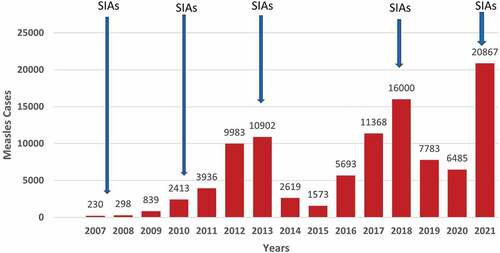Dear editor,
Measles, a leading cause of morbidity and mortality in children worldwide, is one of the most contagious diseases, with a basic reproduction number of 12 to 18 which is much higher than that of the Ebola and SARS-CoV-2.Citation1,Citation2 Despite the availability of a safe and effective vaccine against measles, the recent setbacks in the efforts to achieve measles elimination goals are alarming. From 2000 to 2016, because of vaccination, the number of reported measles cases globally decreased by 84%. However, surprisingly, between 2016 and 2019 the number of measles cases increased by 656%, the highest recorded percentage gain since 1996.Citation1 Several countries in the European and American regions lost their elimination status in 2018 and 2019 due to vaccine hesitancy or a decline in vaccination coverage.Citation3
Pakistan is amongst the top 5 countries in the world with the highest burden of measles due to low coverage of routine vaccination and hundreds of children losing their lives due to measles in the country. Measles has been endemic in Pakistan for decades and accounts for 65% of the total disease burden in the Eastern Mediterranean region.Citation4 The actual coverage of routine vaccination against measles was already very low in Pakistan and the COVID-19 pandemic make it worse as a result over 20,000 measles cases and 800 measles-related deaths were reported in 2021. To overcome this serious measles epidemic situation in the country, the government of Pakistan in collaboration with the World Health Organization (WHO), Global Alliance for vaccine and immunization (GAVI), and United Nation International Children emergency funds (UNICEF) conducted a countrywide Measles-Rubella (MR) vaccination campaign from 15 to 27 November 2021. More than 90 million children between 9 months to 15 years of age were vaccinated against Measles and Rubella across the country. More than 386,000 health professionals, including 76,000 vaccinators and more than 143,000 social mobilizers have participated for the successful implementation of the MR campaign in Pakistan.Citation5 Previously, more than 4 countrywide measles vaccination campaigns were conducted in 2007–2008, 2010–2011, 2013, and 2018 and more than 232.5 million children were vaccinated against measles during these campaigns. All these vaccination campaigns showed very successful results in reducing the measles cases over the next few years []. However, due to the low coverage of routine vaccination, Pakistan needs vaccination campaigns after every 2 to 3 years. Countrywide measles vaccination campaigns are important mechanisms to control and eliminate measles in endemic countries like Pakistan, however, measles elimination cannot be achieved without achieving more than 95% coverage of routine vaccination. Measles containing vaccine-1 and 2 (MVC1 and MCV2) were introduced in the schedule of routine immunization in 1974 and 2009 in Pakistan, respectively.Citation6 Surprisingly, and unfortunately, the coverage of routine vaccination was estimated to be below 50% in 2000 and still below 50% in 2019.Citation7 WHO recommended that countries aiming at measles elimination should achieve ≥95% routine vaccination coverage. Countries that have not fully achieved such coverage have never interrupted measles transmission and have experienced some of the recorded outbreaks as happened in Pakistan. The measles vaccine has prevented more child deaths than any other vaccine in use today and on the other hand, it is at the top of the list concerning safety, and immunogenicity. To reduce reliance on supplementary immunization activities, health authorities in Pakistan must be the focus and invest to increase the coverage of routine vaccination. Countries like Pakistan with low vaccination coverage and a weaker health-care system have rarely approached the level that would be required for measles elimination.
Measles elimination can be achieved through the combination of high vaccination coverage and supplementary immunization activities (SIAs). SIAs have an important role in reducing measles transmission and filling immunity gaps but are not sufficient to achieve measles elimination in a country like Pakistan with insufficient vaccination coverage. Recently, the world’s largest MR vaccination campaign has successfully been conducted in Pakistan. We strongly recommend that this is the time to invest in the strengthening of routine vaccination coverage, which has remained very low for decades. Countries that have achieved measles elimination have invested heavily in routine vaccination programs to ensure high vaccination coverage against measles and other vaccine-preventable diseases. The reemergence of measles in many countries results from stagnant and falling coverage of routine vaccination. COVID-19 pandemic is making routine mass vaccination for other diseases in developing countries more difficult putting the world at even greater risk for major outbreaks of measles and other vaccine-preventable diseases. Close monitoring of routine vaccination coverage, active surveillance, accurate diagnosis, rapid response, and quality data is the priority components of measles elimination.
At this critical time, more than ever, political will is needed to fund the required structural changes in vaccination programs in Pakistan to protect all children against measles and other vaccine-preventable diseases through routine vaccination.
Disclosure statement
No potential conflict of interest was reported by the author(s).
Additional information
Funding
References
- Rana MS, Alam MM, Ikram A, Salman M, Mere MO, Usman M, Umair M, Zaidi SS, Arshad Y. Emergence of measles during the COVID-19 pandemic threatens Pakistan’s children and the wider region. Nat Med. 2021;27(7):1–2. doi:10.1038/s41591-021-01430-6.
- Roberts L. Measles is on the rise-and Covid-19 could make it worse. Nature. 2020;580(7804):446–47. doi:10.1038/d41586-020-01011-6.
- Namaki S, Gouya MM, Zahraei SM, Khalili N, Sobhani H, Akbari ME. The elimination of measles in Iran. Lancet Global Health. 2020;8(2):e173–e174. doi:10.1016/S2214-109X(20)30002-4.
- Rana MS, Ikram A, Salman M, Usman M, Umair M. Negative impact of the COVID-19 pandemic on routine childhood immunization: experience from Pakistan. Nat Rev Immunol. 2021;21(11):689–90. doi:10.1038/s41577-021-00627-7.
- Pakistan to immunize more than 90 million children against measles and rubella; 2021 Dec 5. https://www.unicef.org/pakistan/press-releases/pakistan-immunize-more-90-million-children-against-measles-and-rubella
- Mere MO, Goodson JL, Chandio AK, Rana MS, Hasan Q, Teleb N, Alexander JP. Progress towards measles elimination in Pakistan, 2000-2018/progres realises en vue de l’elimination de la rougeole au Pakistan, 2000-2018. Weekly Epidemiological Rec. 2019;94:281–89.
- Cutts FT, Ferrari MJ, Krause LK, Tatem AJ, Mosser JF. Vaccination strategies for measles control and elimination: time to strengthen local initiatives. BMC Med. 2021;19(1):1–8. doi:10.1186/s12916-020-01843-z.

